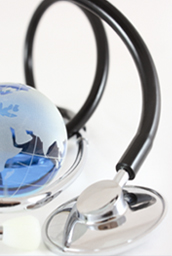
Abstracts
Doctor-Patient Relationship in the
Internet Era
Prof. Jonathan Halevy, Director General Shaare Zedek
Medical
Expectations of patients from their physicians -- both
family physicians and specialists -- have changed
significantly in the last three decades. Outstanding among
the characteristics of current medical practice is the
"educated patient" who presents his problems to the treating
physician with a background of information derived
unselectively from the Internet.
A prominent paradox is manifested by the fact that while
modern medicine is able to provide ultra-sophisticated
evidence- based diagnostic and therapeutic modalities, a
large segment of the public prefers to turn to non-
evidence-based holistic complementary and alternative
medicine modalities. Are the two phenomena connected? How
should the medical community deal with these trends and what
is their impact on the doctor-patient relationship and on
possible cure rates?
In my presentation I will try to shed light on the
doctor-patient relationship in our era in view of the
scientific and technological changes currently taking place
in the practice of medicine.
The Digital Transformation of American
Radiology
Dieter Enzmann MD, Chair of UCLA Radiology
The era of "big data" promises to transform radiology. The
current radiology business model is a professional service
that is being digitally deconstructed into components, with
each component being transformed by computational
bioinformatics. Bioinformatics involves the use of
computational techniques in pattern recognition, data
mining, machine learning, visualization and other techniques
to unravel biologic mechanisms. The data mining subset of
bioinformatics is already affecting radiology and will
transform the shared standards on which the profession is
based. As the standards change, the profession will
transition into an information business. This transition
will accelerate as image interpretation begins to tap into
both national and international databases to make use of
"population images."
The data mining version of bioinformatics will have several
manifestations, including "population images,"
"radiogenomics," "computational radiology" and ultimately
Watson-like diagnostic computers. The summation of one or
more image features from a global data set can create
phenotypic "population images." That image feature depicted
may be an anatomic structure, a disease manifestation, a
tumor characteristic or a hemodynamic abnormality. Such
"population images" can be used to classify an individual
disease/health state, or they can compare different
treatment groups in clinical trials.
Bioinformatic techniques in non-imaging databases can be
mined in conjunction with imaging databases to better
understand biologic mechanisms. Image phenotypes are the end
product of complex, combined cellular and tissue network
behavior and may provide a means for teasing out such
biologic network behavior at multiple levels of organization
between the genomic and organ levels. Radiogenomics,
therefore, consists of correlating image phenotypes captured
in population images to different scales of molecular
phenotypes to illuminate underlying biologic mechanisms.
Since diagnostic imaging and molecular diagnosis are both
individually valuable services, why not integrate them?
Integration provides incremental value if the information
being linked is normally used at the same point in time and
space. Clinical imaging phenotypes and histologic/molecular
phenotypes provide different tiers of complementary
information about the state of biologic networks in cells
and tissue. Integration of this information into an
information business "product" can save time in diagnosing
and monitoring diseases. Such integrated products can use
serial imaging as an organizing principle for managing
chronic diseases.
Adopting the principles of systems biology, we can create
"systems radiology," which uses a limited number of image
features to define cell and tissue network states. "Systems
radiology" will require "computational radiology," which
refers to the ability to extract on a large scale meaningful
image patterns using search, segmentation and statistical
algorithms. "Computational radiology" generates "systems
radiology," which can be correlated with "systems biology."
The search for validated imaging biomarkers will depend on
linking "systems radiology" and "systems biology" via
innovative unstructured or structured data mining.
Unstructured mining purposely bypasses the filter of human
vision to identify correlations with potential biologic
significance. The structured approach uses human identified
imaging features and subjects them to hypothesis testing not
for creating new prospective experiments, but rather to
extensively searching data derived from already performed,
variegated experiments.
Radiology will need to adapt techniques and algorithms
developed in bioinformatics and systems biology to clinical
imaging. Powerful computational techniques will create
humanized diagnostic computers, which can become fast, cost
effective tools in a radiology information business.
Radiologists will play a key role in providing the necessary
intuition to productively integrate computational personal
medical reality. It is early, but radiology will be
transformed from a transactional, professional service to an
information business composed of professionals.
From Biological Discovery and
Personalized Medicine: The Role of Computation in Human
Genetics
Itsik Pe'er PhD, Columbia University
Investigation of the statistical association between
variation in inherited DNA sequences and clinically relevant
traits is predicated by the high heritability of such
characteristics. Such genetic research is dually aimed. On
one hand, the goal is scientific, to identify molecular
underpinnings of disease, understanding mechanisms and thus
potentially leading to development of treatment. The other
goal is diagnostic, allowing care that is tailored to each
patient based on their genetic makeup. Recent technological
breakthroughs have exponentially sped up production of
genetic data, producing a deluge of information. While these
trends usher in the implementation of personalized medicine,
they also highlight analytical challenges in such large
scale data.
The talk will provide a survey of the field, with examples
from our own work on methodology for detecting hidden
relatedness and gene-gene interaction with application to
direct-to-consumer genetics, pharmacogenetics and isolated
populations.
